Effect of vegetable fat on the texture, colour and sensory properties of Macedonian white brined cheese
IF 1.1
4区 农林科学
Q3 AGRICULTURE, DAIRY & ANIMAL SCIENCE
引用次数: 5
Abstract
This study aimed to investigate the influence of substitution of milk fat with palm fat on the composition, yield and technological quality of White cheese, a Macedonian traditional cheese. In this study, fullfat white brined cheese was used as a control sample (WC), while experimental cheeses were prepared from cow milk with vegetable fat (WV) addition and low-fat cheese (WL), respectively. The cheeses have been analysed for physicochemical (acidity, pH, fat, fat acidity, protein), instrumental texture and colour properties (L, a, b) as well as the sensory properties after 1, 20 and 60 days. WV cheeses showed a significantly (P<0.05) lower degree of pH and higher titratable acidity than the WC and WL cheese samples. Cheese that contained vegetable fat showed lower degrees of lipolysis, as assessed by the acid-degree value and received significantly (P<0.05) better appearance, highest hardness value (5226.98 N) and cheese yield scores compared to other samples.植物脂肪对马其顿白腌奶酪质地、颜色和感官特性的影响
本研究旨在探讨棕榈脂肪替代乳脂对马其顿传统奶酪白奶酪的成分、产量和工艺质量的影响。在本研究中,全脂白卤奶酪被用作对照样品(WC),而实验奶酪分别由添加植物脂肪(WV)的牛奶和低脂奶酪(WL)制备。对奶酪的理化性质(酸度、pH值、脂肪、脂肪酸度、蛋白质)、仪器质地和颜色特性(L、a、b)以及1、20和60天后的感官特性进行了分析。与WC和WL奶酪样品相比,WV奶酪的pH值和可滴定酸度显著降低(P<0.05)。根据酸值评估,含有植物脂肪的奶酪显示出较低的脂解程度,与其他样品相比,其外观、硬度值最高(5226.98N)和奶酪产量得分显著(P<0.05)。
本文章由计算机程序翻译,如有差异,请以英文原文为准。
求助全文
约1分钟内获得全文
求助全文
来源期刊

Mljekarstvo
Agricultural and Biological Sciences-Animal Science and Zoology
CiteScore
1.90
自引率
41.70%
发文量
18
审稿时长
12 weeks
期刊介绍:
Mljekarstvo is an open access, peer-reviewed international quarterly scientific journal. The first issue was published in 1951, by the Croatian Dairy Operators'' Association (today: Croatian Dairy Union, publisher). In a paper at a Union conference held 28 October 1951 in Zagreb it was said: "Our desire is that this magazine does not meet the fate of its predecessors, but that it continues to reflect the creative efforts and to provide guidelines for the producers as well as all other operators employed in the dairy industry."
It is our pleasure today to say that wishes of the enthusiasts who attended the conference have come true, and the magazine Mljekarstvo during the last six decades was a reflection of the creative efforts of numerous dairy scientists and experts, and through its texts it served as a guideline in improving production and processing of milk and dairy products. Mljekarstvo has been following all the achievements of the dairy profession in Croatia, and it also gives the short surveys of world achievements. The result of the research of local and foreign scientists and experts always find their place in the magazine Mljekarstvo. It has been edited by our outstanding dairy experts employed at colleges, research institutions and dairy companies.
 求助内容:
求助内容: 应助结果提醒方式:
应助结果提醒方式:


